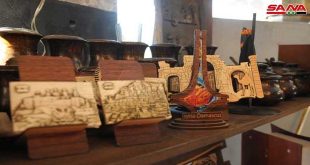Damascus, SANA_ Damascus is famous of its ancient Hammams (public baths), which still preserve within their alleys tales of the past and a beloved social rituals.
The architects raced to ornament and adorn these Hammams with beautiful artistic decorations to became one of the historical landmarks that characterized this ancient city.
Going to the Hammam was a social habit of life in the Orient in general and in Damascus in particular.
Public baths were common in the city when houses of the past centuries did not have private baths, so men used to slip to the baths to wash their bodies and enjoy the services offered there for an hour or two, where as women changed this habit into a traditional social event linked to their social life.
By time, public baths were linked to several social occasions like marriages, births, and preparations for feasts.
Although Damascus baths were of different sizes, decorations and designs, their main structure was identical.
They had three main sections: “al-Barani”, is the outer section of the Hammam or the so-called frigidarium and often contains a roofed courtyard surrounded by windows and had a fountain or two in the center surrounded by desks or chairs.
“Al-Wistani” is the central room, it is of moderate temperature and covered with domes containing glass openings to allow the sun to enter.
“Al-Jowani” or the interior hot room, consists of two parallel iwans located on both sides of the House of Fire from which rooms containing their own basins branch out.
Very few of the Hammams had an entrance and an interior only. A hammam visitor used to get into the lobby, which on both sides used to have two small rooms and two or more decks, several steps high, where customers can take off their clothes and receive towels and sheets to cover their bodies.
The central and interior sections, specified for washing, usually had small chambers on both sides, each one had two or more stone basins with water pouring in them from two taps for hot and cold water, with wooden corks to control the flow of water. The ground floor and walls usually covered with marble tiles, while the roofs were domed with several round openings closed with thick glass bulbs to allow sun light into the rooms. These two sections have no windows in order to keep temperature stable in the hammam all the day.
The process is similar to that of a sauna, It starts with relaxation in a room heated by a continuous flow of hot, dry air, allowing the bather to perspire freely. Bathers may then move to an even hotter room before they wash in cold water. After performing a full body wash and receiving a massage, bathers finally retire to the cooling-room for a period of relaxation.
Water was drawn to hammams through clay pipes to the boilers, to cold water taps and to the ponds inside. Each hammam had a main pipe that drives water from a nearby river or water source. Staff of the hammam usually consisted of the master who is usually the owner or lessee of the bath, aided by several workers; the receptionist who receives customers and offers them towels, soap,..etc, “al-Mokayes” who usually rubs client bodies with a special woolen glove, the masseur, the waiter who serves hot and cold drinks, and the boiler operator who is in charge of heating water.
The number of hammams in Damascus varied according to the growth of population and degree of economic development. But with the advance of time and the appearance of private home baths began to decrease.
Many hammams have been restored and modernized to receive local people as well as tourists, who all agree that Damascene hammams are unique for their elegant buildings, clean interiors, abundance of water and good service.
Gh.A.Hassoun
 Syrian Arab News Agency S A N A
Syrian Arab News Agency S A N A




